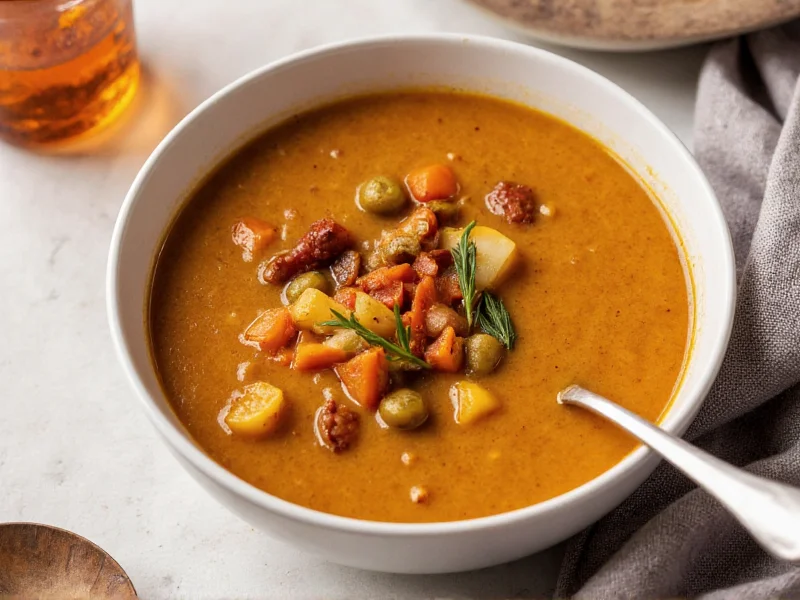Creating exceptional roasted vegetable soup transforms simple ingredients into a culinary masterpiece through the magic of the Maillard reaction. Unlike traditional boiled vegetable soups, roasting concentrates natural sugars and develops complex flavor compounds that create a richer, more satisfying broth without added sugars or artificial enhancers. This technique works particularly well with root vegetables and hardy produce that benefit from high-heat caramelization.
The Science Behind Superior Flavor Development
When vegetables roast at high temperatures, their natural sugars undergo caramelization while proteins trigger the Maillard reaction—chemical processes that create hundreds of new flavor compounds. This explains why roasted vegetable soup consistently outperforms its boiled counterpart in blind taste tests. The key vegetables that respond best to roasting include:
| Vegetable | Optimal Roasting Time | Flavor Contribution |
|---|---|---|
| Carrots | 25-30 minutes | Natural sweetness with earthy depth |
| Parsnips | 25-30 minutes | Nutty, complex sweetness |
| Sweet potatoes | 20-25 minutes | Creamy texture with caramel notes |
| Onions | 20-25 minutes | Deep umami foundation |
| Garlic (whole cloves) | 15-20 minutes | Mellow, roasted garlic essence |
Professional Roasting Techniques for Maximum Flavor
Achieving restaurant-quality roasted vegetable soup at home requires attention to critical details that many recipes overlook. First, cut vegetables into uniform 1-inch cubes to ensure even cooking—smaller pieces burn, while larger chunks won't caramelize properly. Second, arrange vegetables in a single layer on parchment-lined baking sheets with adequate space between pieces; overcrowding causes steaming instead of roasting.
For optimal browning, toss vegetables with just enough olive oil to coat (about 2 tablespoons per baking sheet), then season with salt before roasting. The salt draws out moisture initially but ultimately promotes better browning. Roast at 400°F (200°C) until deeply caramelized at the edges—this typically takes 25-35 minutes for most root vegetables. Resist stirring too frequently; let vegetables develop that crucial sear.
Building Layers of Flavor in Your Soup
After roasting, deglaze your baking sheet with a splash of broth or water to capture every bit of flavorful fond before transferring vegetables to your pot. For roasted vegetable soup with extraordinary depth, incorporate these professional techniques:
- Add a tablespoon of tomato paste to the pot before adding broth and cook for 2 minutes to deepen flavor
- Include a Parmesan rind while simmering for subtle umami enhancement
- Finish with a splash of acid (lemon juice or apple cider vinegar) to brighten flavors
- Blend while hot for smoother texture, but allow steam to escape to prevent explosions
Storage and Reheating for Best Results
Properly stored roasted vegetable soup maintains quality for up to 5 days in the refrigerator or 3 months frozen. When reheating, add a small amount of broth or water as the soup thickens upon standing. For best texture, avoid boiling when reheating—gentle simmering preserves the delicate roasted vegetable flavors that high heat can diminish.
Variations for Different Dietary Preferences
This versatile roasted vegetable soup base adapts beautifully to various dietary needs. For vegan roasted vegetable soup, omit dairy and use coconut milk for creaminess. To create a protein-rich version, add white beans or lentils during the simmering stage. Those seeking low-carb roasted vegetable soup options can emphasize cauliflower, broccoli, and zucchini while reducing higher-carb vegetables like potatoes.
Troubleshooting Common Issues
Even experienced cooks encounter challenges with roasted vegetable soup. If your soup tastes bitter, you likely over-roasted the vegetables—next time reduce roasting time by 5-10 minutes. For thin broth, roast additional onions and carrots specifically for thickening, or blend in a small cooked potato. When soup lacks depth, add a teaspoon of soy sauce or miso paste during simmering for umami boost without altering the vegetable-forward profile.
Nutritional Benefits of Roasted Vegetable Soup
Beyond exceptional flavor, roasted vegetable soup delivers significant nutritional advantages. The roasting process preserves more antioxidants than boiling, particularly in vegetables like carrots and beets. The natural sweetness developed through roasting reduces the need for added sugars while increasing satisfaction from the meal. This nutrient-dense soup provides vitamins A and C, fiber, and various phytonutrients that support immune function and digestive health.
Perfect Pairings and Serving Suggestions
Elevate your roasted vegetable soup experience with thoughtful accompaniments. A drizzle of high-quality olive oil or pesto adds richness, while a sprinkle of toasted pumpkin seeds provides textural contrast. Serve with crusty whole-grain bread for dipping, or pair with a simple green salad for a complete meal. For special occasions, garnish with fresh herbs like thyme or chives and a dollop of Greek yogurt for added protein.
Frequently Asked Questions
What vegetables work best for roasted vegetable soup?
Root vegetables like carrots, parsnips, sweet potatoes, and beets perform exceptionally well in roasted vegetable soup. Onions, garlic, and celery root also develop deep flavors through roasting. Avoid watery vegetables like zucchini until the final stages to prevent mushiness.
Can I make roasted vegetable soup without an oven?
Yes, you can achieve similar results by using your stovetop. Sear vegetables in a heavy-bottomed pot with oil over medium-high heat, allowing them to develop a golden crust before adding broth. This method won't produce identical flavors to oven roasting but creates a delicious caramelized vegetable soup alternative.
How do I prevent my roasted vegetable soup from becoming too sweet?
Balance natural sweetness by adding acidic elements like lemon juice or apple cider vinegar at the end. Incorporate savory elements such as tomato paste, soy sauce, or miso during cooking. Using more onions and garlic relative to sweet vegetables like carrots and sweet potatoes also helps maintain flavor balance.
Why does my roasted vegetable soup taste bland compared to restaurant versions?
Restaurant-quality roasted vegetable soup typically features deeper caramelization through precise temperature control and adequate spacing during roasting. They also often use vegetable or mushroom stock instead of water, and finish with acid and fresh herbs. Proper seasoning at each stage—before roasting, during simmering, and at serving—makes a significant difference.











 浙公网安备
33010002000092号
浙公网安备
33010002000092号 浙B2-20120091-4
浙B2-20120091-4